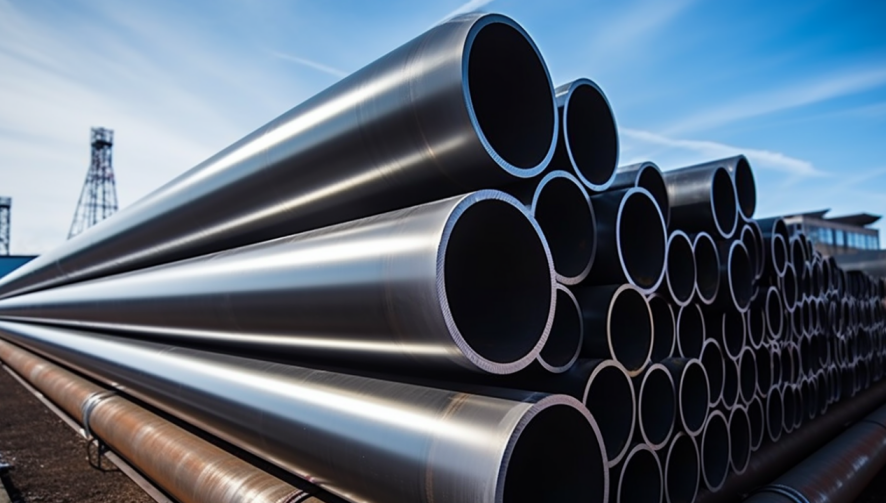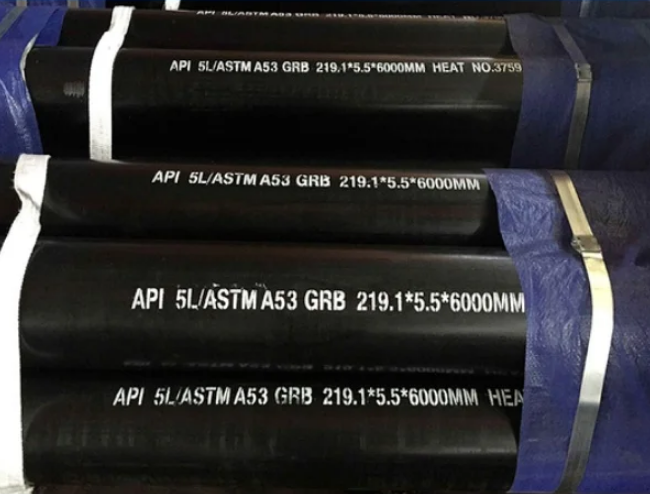What is ASTM A53 Pipe for Various Project Needs?
What is ASTM A53 Pipe? ASTM A53 is a specification for carbon steel alloy pipes, widely used in structural steel and low-pressure pipeline applications. It encompasses seamless and welded black and hot-dipped galvanized steel pipes, available in sizes from NPS 1/8″ to NPS 26. Known also as ASME SA53, this specification is esteemed for its versatility and exceptional performance across various applications.

Benefits of ASTM A53 Pipe
Durability and Strength
ASTM A53 pipes are celebrated for their remarkable durability and strength. The carbon steel composition enables these pipes to endure high pressure and significant mechanical stress, making them ideal for demanding environments where long-lasting performance is essential.
Versatility in Applications
A key advantage of ASTM A53 pipes is their broad versatility. These pipes are suitable for a wide array of applications, including steam, water, gas, and airline systems. This versatility streamlines inventory management and project execution by reducing the need for multiple types of pipes.
Ease of Fabrication and Installation
ASTM A53 pipes are notably easy to fabricate and install. They can be welded or joined using various methods, offering flexibility in construction and maintenance. This ease of fabrication and installation makes them a preferred choice among contractors and engineers.
Applications of ASTM A53 Pipe in Various Projects
Structural Applications
Building Frameworks ASTM A53 pipes are extensively utilized in construction, particularly for frameworks and foundations. Their robust strength and durability provide essential support, ensuring the stability and safety of structures. These pipes can bear significant loads, making them ideal for high-rise buildings and large-scale infrastructure projects.

Infrastructure Projects In infrastructure projects like bridges, roads, and tunnels, ASTM A53 pipes are indispensable. Their resistance to environmental factors, including corrosion and weathering, makes them suitable for long-term use in these critical applications. These pipes offer essential support, ensuring the integrity and longevity of infrastructure.
Industrial Structures Industrial facilities often require sturdy piping systems to support heavy machinery and equipment. ASTM A53 pipes, known for their strength and high-pressure resistance, are ideal for these environments. They are used in various industrial structures to transport fluids and gases efficiently and safely.
Low-Pressure Pipeline Applications
Water Distribution Systems ASTM A53 pipes are employed in water distribution systems to transport water at low pressure. Their corrosion resistance and durability ensure the safe and efficient delivery of water to residential, commercial, and industrial areas, maintaining the reliability of water supply networks.
Steam Lines These pipes are also suitable for steam lines in various applications. Their capacity to handle high temperatures and pressures makes them reliable for transporting steam in industrial processes, ensuring efficient steam transfer crucial for many industrial systems.
Gas Pipelines Gas distribution networks rely on ASTM A53 pipes for the safe transport of gas at low pressure. Designed to prevent leaks and withstand mechanical stresses associated with gas transport, these pipes are preferred for their durability and reliability in gas pipeline applications.
Mechanical Applications
Hydraulic Systems In hydraulic systems, ASTM A53 pipes are used to transport hydraulic fluids under high pressure. Designed to handle extreme pressure and mechanical stress, these pipes ensure the efficient operation of hydraulic machinery and equipment due to their strength and durability.
HVAC Systems Heating, ventilation, and air conditioning (HVAC) systems utilize ASTM A53 pipes for the transport of air and fluids. Chosen for their pressure resistance and corrosion resistance, these pipes play a vital role in ensuring the efficient and reliable operation of HVAC systems in residential, commercial, and industrial buildings.
Fire Protection Systems ASTM A53 pipes are commonly used in fire protection systems, including sprinkler systems and fire hydrant lines. Their ability to handle high pressure and resist corrosion makes them suitable for these critical applications. These pipes ensure the reliable delivery of water in emergencies, providing essential fire protection.
Solutions for Project Needs with ASTM A53 Pipe
Versatility and Adaptability
Wide Range of Sizes A significant advantage of ASTM A53 pipes is their availability in a diverse range of sizes. This enables engineers and contractors to select the precise pipe size needed for their specific project requirements. Whether for structural support or fluid transport, there is an ASTM A53 pipe perfectly suited to the task.
Seamless and Welded Options ASTM A53 pipes come in both seamless and welded forms, providing versatility in application. Seamless pipes, with their uniform strength and structure, are ideal for high-pressure scenarios. Conversely, welded pipes offer a cost-effective solution for lower-pressure applications. This range of options ensures that project specifications can be met efficiently and economically.
Hot-Dipped Galvanized Coating For applications demanding enhanced corrosion resistance, ASTM A53 pipes are available with a hot-dipped galvanized coating. This coating adds an extra layer of protection, significantly extending the lifespan of the pipes in corrosive environments. This makes them highly suitable for outdoor and industrial settings where exposure to corrosive elements is prevalent.
Ease of Fabrication and Installation
Welding and Joining Methods ASTM A53 pipes can be easily fabricated and joined using various welding techniques. This flexibility allows for the quick and efficient assembly of piping systems. Whether for new installations or repairs, these pipes can be tailored to meet the specific needs of any project.
Lightweight and Easy Handling Despite their robust strength, ASTM A53 pipes are relatively lightweight, facilitating easy handling and installation. This characteristic reduces labor costs and accelerates the construction process. Additionally, the ease of handling minimizes the risk of damage during transport and installation, ensuring the integrity of the piping system.
Cost-Effective Solutions
The versatility and durability of ASTM A53 pipes offer cost-effective solutions for a wide range of projects. Their long lifespan and low maintenance requirements contribute to reducing the overall cost of ownership. This makes them an economical choice for both large-scale infrastructure projects and smaller residential applications.

Seamless Steel Pipe Production Process
Cold-Drawn Seamless Steel Tubes
Heating and Perforation
The production of cold-drawn seamless steel tubes begins with heating the tube blank, followed by perforation. This process creates a hollow tube that can be further processed.
Annealing and Pickling
After perforation, the tube undergoes annealing and pickling. Annealing improves the material's ductility, while pickling removes surface impurities, preparing the tube for further drawing.
Multiple Cold Drawing and Heat Treatment
The tube is then subjected to multiple cold drawing processes to achieve the desired dimensions and properties. This is followed by heat treatment to enhance the mechanical properties of the tube.
Hot-Rolled Seamless Steel Pipe
Tube Billet Heating and Perforation
In the hot-rolled seamless steel pipe production process, the tube billet is first heated and then perforated. This creates the initial hollow tube structure needed for further rolling.
Three-Roller/Cross-Rolling and Continuous Rolling
The perforated tube undergoes three-roller or cross-rolling and continuous rolling processes. These methods ensure uniform thickness and desired mechanical properties.
Cooling and Straightening
After rolling, the tube is cooled and straightened. These steps are crucial to achieving the final shape and ensuring the tube meets the required specifications.

Conclusion
ASTM A53 pipes are indispensable across various industries, renowned for their durability, versatility, and ease of installation. Whether utilized in structural applications, low-pressure pipelines, or mechanical systems, these pipes consistently deliver reliable performance and long-term benefits. The manufacturing processes for seamless steel pipes, both cold-drawn and hot-rolled, ensure high-quality products that adhere to stringent standards. Suppliers like Cangzhou Shenlong Pipe Manufacturing Co., Ltd. offer an extensive range of ASTM A53 pipes, catering to diverse project requirements and significantly contributing to the success of numerous engineering and construction endeavors.






